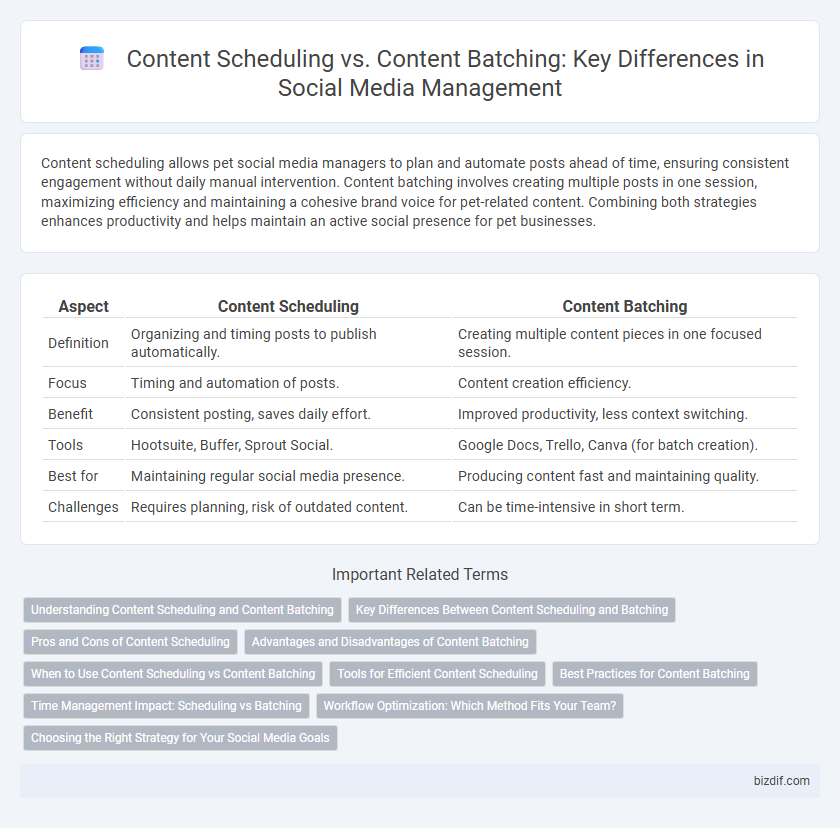Content scheduling allows pet social media managers to plan and automate posts ahead of time, ensuring consistent engagement without daily manual intervention. Content batching involves creating multiple posts in one session, maximizing efficiency and maintaining a cohesive brand voice for pet-related content. Combining both strategies enhances productivity and helps maintain an active social presence for pet businesses.
Table of Comparison
| Aspect | Content Scheduling | Content Batching |
|---|---|---|
| Definition | Organizing and timing posts to publish automatically. | Creating multiple content pieces in one focused session. |
| Focus | Timing and automation of posts. | Content creation efficiency. |
| Benefit | Consistent posting, saves daily effort. | Improved productivity, less context switching. |
| Tools | Hootsuite, Buffer, Sprout Social. | Google Docs, Trello, Canva (for batch creation). |
| Best for | Maintaining regular social media presence. | Producing content fast and maintaining quality. |
| Challenges | Requires planning, risk of outdated content. | Can be time-intensive in short term. |
Understanding Content Scheduling and Content Batching
Content scheduling involves planning and automating posts to publish at specific times, ensuring consistent engagement across social media platforms. Content batching refers to creating a large volume of content in one dedicated session to increase efficiency and maintain quality. Both strategies streamline social media management by optimizing workflow and maintaining regular audience interaction.
Key Differences Between Content Scheduling and Batching
Content scheduling involves planning and publishing posts at specific times to maintain consistent audience engagement, while content batching focuses on creating multiple pieces of content in one session to enhance productivity. Scheduling ensures timely distribution aligned with peak engagement periods, whereas batching optimizes content creation by minimizing context switching. The key difference lies in scheduling's emphasis on timing and publishing, contrasted with batching's focus on efficient content production.
Pros and Cons of Content Scheduling
Content scheduling offers the advantage of maintaining a consistent posting frequency, which improves audience engagement and brand visibility on platforms like Instagram, Facebook, and Twitter. It allows for automation through tools like Buffer, Hootsuite, or Sprout Social, saving time and reducing the risk of missed posting times. However, scheduling can limit flexibility to respond in real-time to trending topics or sudden changes in the social media landscape, potentially decreasing content relevance.
Advantages and Disadvantages of Content Batching
Content batching improves efficiency by allowing social media managers to create multiple posts in one session, reducing the time spent on context switching and increasing focus. However, this approach can limit spontaneity and timely engagement, as pre-planned content may not align with real-time trends or immediate audience interactions. Balancing content batching with flexibility ensures consistent quality while maintaining responsiveness to dynamic social media environments.
When to Use Content Scheduling vs Content Batching
Content scheduling is ideal for maintaining consistent posting across multiple platforms, ensuring timely delivery and audience engagement by pre-planning posts. Content batching suits periods requiring concentrated focus, allowing marketers to create multiple pieces of content in one session, boosting efficiency and creativity. Combining both strategies optimizes workflow by leveraging the strengths of scheduled consistency and batch productivity.
Tools for Efficient Content Scheduling
Content scheduling tools like Hootsuite, Buffer, and Later streamline the process by allowing users to plan and automate posts across multiple social media platforms, ensuring consistent engagement. Content batching tools such as Trello, Notion, and Asana enhance workflow by organizing content creation tasks and deadlines in one place, making it easier to manage large volumes of posts. Utilizing these tools together optimizes social media strategies by balancing strategic planning with efficient content execution.
Best Practices for Content Batching
Content batching enhances social media management by grouping similar tasks, such as writing, designing, and scheduling posts, into dedicated time blocks to improve efficiency and consistency. Best practices for content batching include creating a detailed content calendar, setting specific goals for each batch, and using automation tools like Buffer or Hootsuite to streamline scheduling. Maintaining focused work sessions and leveraging analytics to refine batch themes ensure a cohesive brand voice and maximized audience engagement across platforms.
Time Management Impact: Scheduling vs Batching
Content scheduling streamlines social media calendars by automating post distribution at optimal times, enhancing consistency and audience engagement with minimal daily effort. Content batching consolidates creation tasks into focused sessions, significantly reducing setup time and cognitive load, leading to increased productivity and more strategic content planning. Both methods improve time management by balancing regular posting schedules with efficient content production workflows.
Workflow Optimization: Which Method Fits Your Team?
Content scheduling allows teams to plan and automate posts for consistent engagement, optimizing time by reducing daily decision-making. Content batching focuses on creating large volumes of content in dedicated sessions, enhancing efficiency and minimizing context switching during production. Choosing the right workflow depends on your team's capacity for planning versus creation and their preference for steady visibility or concentrated productivity bursts.
Choosing the Right Strategy for Your Social Media Goals
Content scheduling involves planning and publishing posts at specific times to maintain consistent engagement, while content batching focuses on creating multiple pieces of content in one session to maximize efficiency. Selecting the right strategy depends on your social media goals, such as increasing reach with timely posts or improving productivity through bulk content creation. Aligning these methods with platform algorithms and audience behavior ensures optimal performance and growth.
Content scheduling vs Content batching Infographic

 bizdif.com
bizdif.com